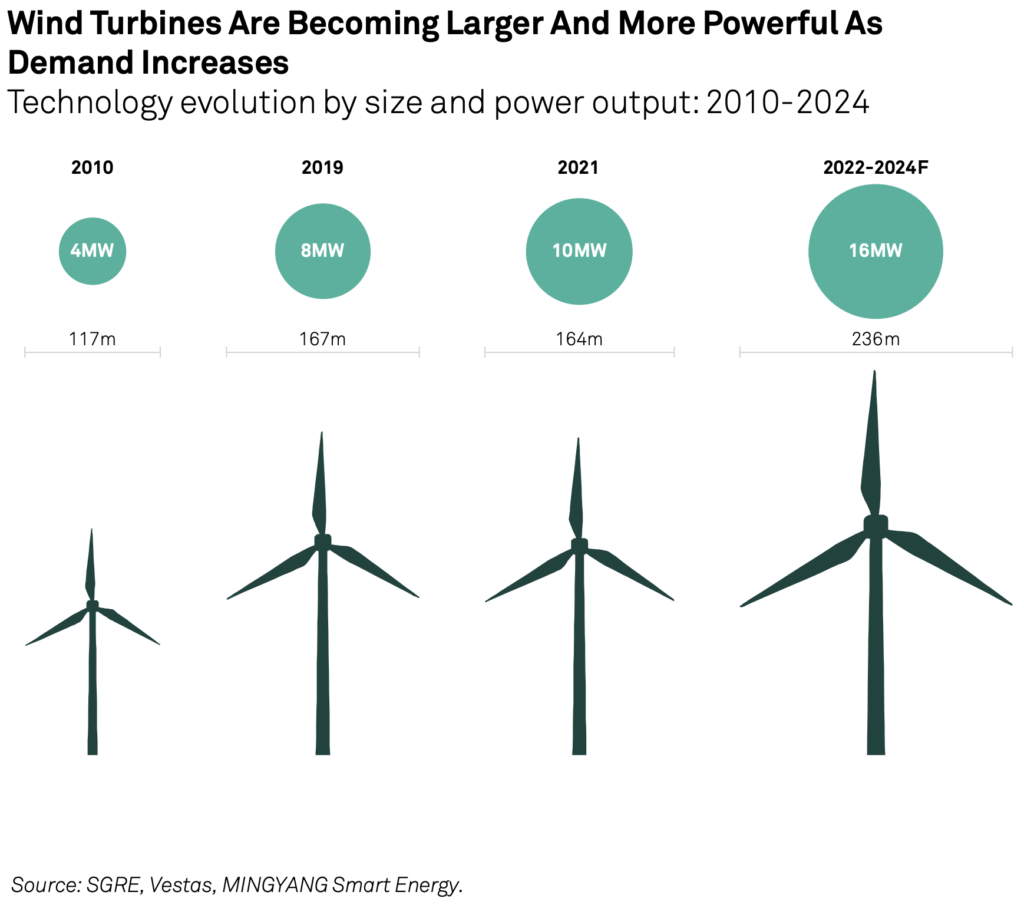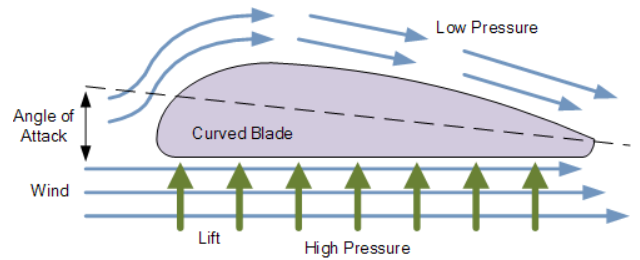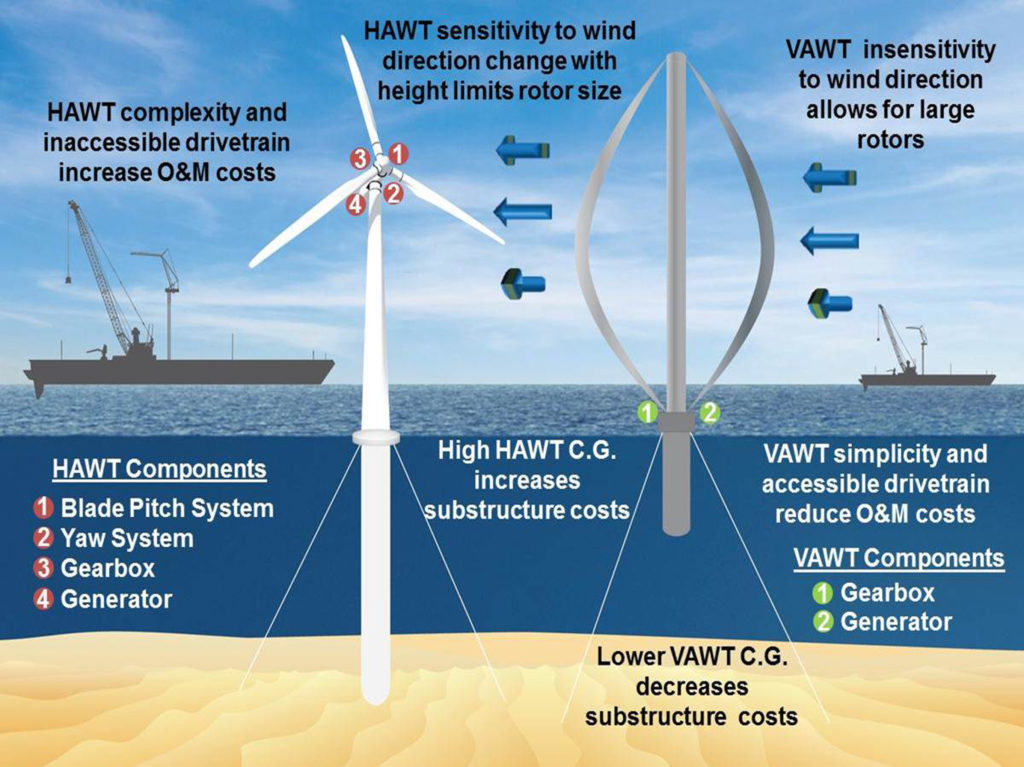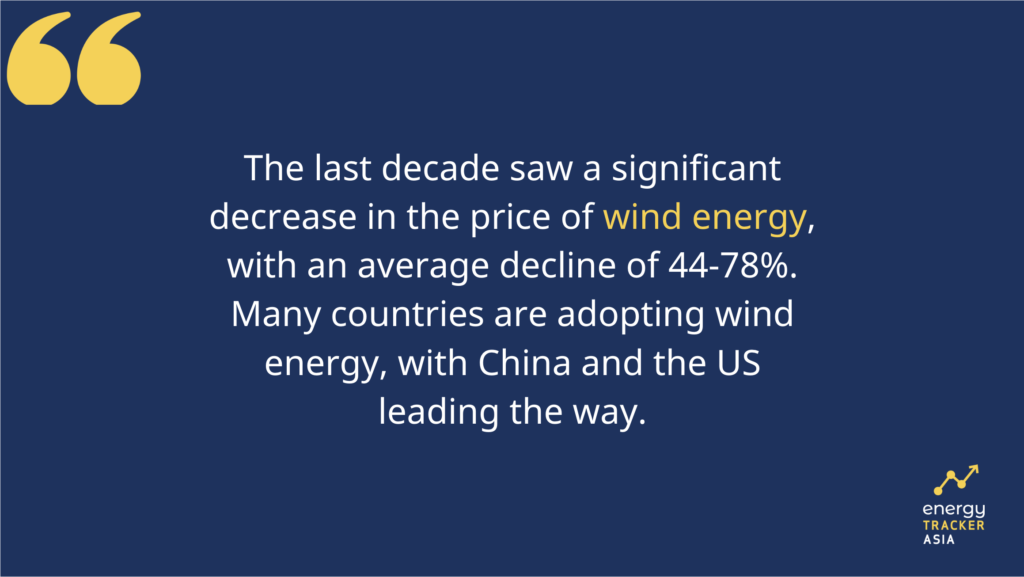How Do Wind Turbines Work?
Source: U.S. Department of Energy
05 August 2022 – by Eric Koons Comments (0)
Wind turbines work by converting the kinetic energy in wind into electricity. This makes them a great renewable energy source for generating electricity. However, their output can also be highly variable and reliant on the intermittency of wind.
Increases in wind turbine efficiency, generation capacity and technology are improving their feasibility. This is particularly true with new designs for varied landscapes and wind speeds. These advancements are already increasing wind energy adoption rates, with wind power playing a significant role in future renewable energy plans.

The Current State of Wind Energy
The last decade saw a significant decrease in the price of wind energy, with an average decline of 44%-78%.
Onshore wind farms can now create electricity at an average cost of USD 0.051 to 0.099 per kilowatt-hour (kWh), with offshore wind farms delivering it at around USD 0.115 per kWh. Considering the decreasing prices, the ease of installation and the low maintenance costs, wind turbines are becoming a go-to energy source in many regions.
Wind energy capacity has increased by a factor of almost 75 since the late 1990s, and experts predict a 9% annual growth rate until at least 2030.
What Is a Wind Turbine?
A wind turbine is a relatively simple device that turns wind energy into electrical energy. It is an excellent source of cheap, green electricity that is favoured around the world for its high electricity generation potential and low land use.
Versatile and scalable, wind turbines can be deployed in onshore and offshore formations, as well as in low-rise residential areas, high-rise urban areas and along highway medians.
How Do Wind Turbines Work Step by Step?
In their basic form, wind turbines are very simple. A wind turbine consists of a rotor with spinning blades, a power generator and a pillar.
Wind makes the blades spin, transferring energy to the power generator. The power generator consists of gears that rotate, turning the energy into electricity. The turbine typically connects to a small network of multiple turbines, which then connect to a larger energy grid.
Wind Turbine Function & Design
Wind turbine blades are designed for efficiency at a variety of wind speeds. As a result, the ideal wind speed for a utility-scale turbine is typically around 48 km/h, with a minimum functional wind speed of approximately 12.8 km/h and a maximum wind speed of approximately 88 km/h. This is achieved through a combination of aerodynamic blade design and efficient energy transfer.

The blades are flat on one side and curved on the other, similar to the wings of a plane. Generally, the curved side increases speed as the wind blows over them, generating a pressure difference. As the pressure difference increases, the blades start moving to compensate for the pressure difference, effectively creating a new zone of low pressure. The continuous nature of the phenomenon means that the blades keep turning for as long as there is wind.
Wind Turbine Types
There are several types of wind turbines for different applications, wind speeds and installation types. Together they form an assortment of products that range from small residential wind turbines to large-scale wind farm with turbines towering as high as 280 meters. As a result, each type of wind turbine design works efficiently in different situations.

Here are the most common wind turbine types:
- Horizontal axis turbines are the most recognizable type of wind turbine. They are easy to scale in size and number.
- Vertical axis turbines are the less popular design. Vertical axis wind turbines take up less space and are suitable for population centres.
- Other innovative wind turbines include typhoon wind turbines and passive wind turbines.
How Does a Wind Turbine Generate Electricity? Step by Step
Wind turbines generate power by capturing the kinetic energy of incoming wind and converting it into electrical energy.
Firstly, the incoming wind transfers its kinetic energy to the turbine blades, forcing them to spin. Secondly, this rotates a generator inside the turbine, which consists of a coiled wire surrounding a magnet. Finally, as the coiled wire rotates around the magnet, it generates an electrical current. The current is captured and transferred into the grid.
As a result, the faster a turbine spins, the more current it generates, resulting in more electrical energy captured.

How Do Wind Turbines Work When it’s not Windy?
Wind turbines are a great way to generate renewable energy, but how do wind turbines work when there is no wind? Although wind turbines rely on the wind to turn the blades and generate electricity, they also have a built-in backup system. This system uses a battery to store the energy generated by the turbine. The battery can then discharge this energy when there is no wind.
How Do Bladeless Wind Turbines Work?
Bladeless wind turbines are a new type of wind turbine that does not use blades to capture the wind. Instead, it uses a shroud or funnel to capture the wind and direct it to the turbine. The turbine then captures the energy in the wind and converts it into electrical energy. Bladeless wind turbines are a new technology, and some testing and development are still needed to make them more efficient.
The Future of Wind Power
The continuing technological advancements and friendly regulatory landscape for wind energy are positive signs that wind turbines will play a growing role in the world’s energy mix. Additionally, many countries are adopting wind energy, with China and the United States leading the way. In 2020, 93 GW of new wind energy capacity came online – the largest annual increase in history.
However, even with this significant growth, it is not enough to ensure the world reaches net-zero by 2050. The world’s energy transition strategy should focus on implementing all forms of renewable energy in the most efficient way possible. A united energy transition strategy is key to global net-zero success.

by Eric Koons
Eric is a passionate environmental advocate that believes renewable energy is a key piece in meeting the world’s growing energy demands. He received an environmental science degree from the University of California and has worked to promote environmentally and socially sustainable practices since. Eric’s expertise extends across the environmental field, yet he maintains a strong focus on renewable energy. His work has been featured by leading environmental organizations, such as World Resources Institute and Hitachi ABB Power Grids.
Read more